Professor Uri Katzenstein | |
|---|---|
אורי קצנשטיין | |
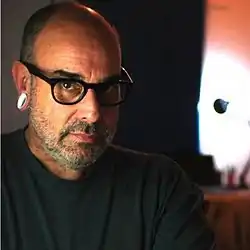 Photo of Uri Katzenstein (Photographer: Avi Levin) | |
| Born | February 17, 1951 Tel Aviv, Israel |
| Died | August 24, 2018 (aged 67) |
| Nationality | Israeli |
| Education | San Francisco Art Institute |
| Known for | Sculpting, visual art, music and film |
| Notable work | "Patʹshegen" (1993) "Family of Brothers" (2000) "Backyard" (2015) |
| Movement | Avant-garde |
| Website | urikatzenstein |
Uri Katzenstein (Hebrew: אורי קצנשטיין; February 17, 1951 – August 24, 2018)[1] was an Israeli visual artist, sculptor, musician, builder of musical instruments and sound machines, and film maker.[2]
Background
Uri was born in Tel Aviv, Israel in 1951 and was the only child of German-born parents who moved to Israel before the Holocaust. In his youth, he played music and joined several Rock bands. In 1969, he joined the Israeli Defense Forces and fought in the Yom Kippur War as a medic.[3][4][5][6] During the late 1970s of the 20th century, Uri studied at the San Francisco Art Institute and after receiving his MFA moved to New York City where he lived and worked throughout the 1980s. His early works, starting from the late 1970s, involved different avant-garde media Exhibits, music, performance, video and sound art. In the mid-1990s of the 20th century, he began creating sculptured Figurines, in addition to objects and sound machines which were all merged and composed as one time-based viewing / listening events.[3][7]
Career
After returning to Israel, he and Noam HaLevi produced the show "Midas". In 1993 he took part in the rock opera "Samara" by Hillel Mittelpunkt and the band Nikmat HaTraktor. In 1999, he issued a music album, along with Ohad Fishof, entitled "Skin O Daayba", which served as the basis for a musical performance. In 2001, he produced the show "Home" along with Renana Raz and Ohad Fishof. In the early 2000s he began to create video art consisting of surreal events while emphasizing subject matter of personal identity. Among his notable works are Patʹshegen (1993) and "Family of Brothers" (Mishpachat ha-Achim; 2000). His early performance work was regularly presented at such legendary performance venues as The Kitchen, No-Se-No, 8BC and Danceteria. His work in sculpture, , video and installation have been exhibited in museums including the Russian State Museum (St. Petersburg), The Chelsea Art Museum (New York City), Kunsthalle Dusseldorf, The Israel Museum, Duke University Museum of Art (North Carolina). Katzenstein participated in the Sao-Paulo Biennale (1991), the Venice Biennale (2001), the Buenos Aires Biennale (first prize, 2002), and the 9th Istanbul Biennale (2005). His performance work appeared in theatres and galleries in London, Berlin, San Francisco, Cardiff (Wales), Santiago de Compostela (Spain), New York City, and Tel Aviv.[3][8]
From 2003 until his death Uri Katzenstein lectured in the Department of Fine Arts of the Faculty of Humanities at the University of Haifa.[9][10]
Death and legacy
Uri Katzenstein died on August 24, 2018, following a stroke.[11]
In September 2018, following his death, an exhibition which he was working on, entitled "The Institute of Ongoing Things" opened at the Jewish Historical Museum in Amsterdam. In January 2019, another art exhibition which he was working on entitled "You Never Know" opened at the ZAZ10TS in Times Square in New York City.[12]
In October 2021, more than three years after his death, an exhibition focusing on the art of Uri Katzenstein entitled "Who Comes After Us?" opened at Holon’s Mediatheque and Center for Digital Art.[13]
Awards
Katzenstein has received the following awards:[3]
- 1982 Creativity Encouragement Award, Israeli Ministry of Education
- 1989 Work Completion Award, Israeli Ministry of Education
- 1992 Grant, The America-Israel Cultural Foundation
- 1998 Grant for Creators in the field of Visual Arts, Israeli Ministry of Education
- 2000 Isracart Award, Tel Aviv Museum of Art
- 2001 Biennale Award, Israeli Pavilion, Venice Biennale, Italy
- 2002 1st prize, Biennale of Art, Buenos Aires, Argentina
- 2014 Dan Sandler and Sandler Foundation Award for Sculpting, Tel Aviv Museum of Art[14][15][16]
- 2017 Dizengoff Prize
Books
- ha-Biʼanaleh ha-benleʼumit ha-21 shel San-Paʼulo 1991, Yiśraʼel (1991). by Nurit Daṿid, Yehoshuʻa Borḳovsḳi, Yiśraʼel Rabinovits, Uri Ḳatzenstein OCLC 58404699
- פתשגן / Patʹshegen (1993). by Uri Katzenstein ISBN 978-965-278-130-7
- Uri Katzenstein : missive : The Israel Museum, Jerusalem, (1993). by Uri Katzenstein OCLC 600838262
- Families (2000). by Uri Katzenstein; Duke University. Evans Family Cultural Residency Program. OCLC 49932271
- Uri Katzenstein : home : Venice Biennale 2001, the Israeli Pavilion (2001). by Uri Katzenstein; Yigal Zalmona; Ishai Adar; Binya Reches OCLC 753440505
- Hope machines (2007). by Uri Katzenstein; Merkaz le-omanut ʻakhshaṿit (Tel Aviv, Israel) OCLC 477287150
- Backyard (2015) by Uri Katzenstein; Tel-Aviv Museum ISBN 978-965-539-109-1
Gallery
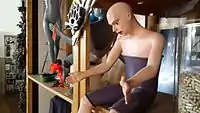 Works by Katzenstein at his studio in Tel Aviv, 14 April 2017
Works by Katzenstein at his studio in Tel Aviv, 14 April 2017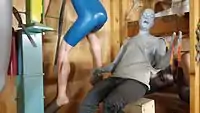 Works by Katzenstein at his studio in Tel Aviv, 14 April 2017
Works by Katzenstein at his studio in Tel Aviv, 14 April 2017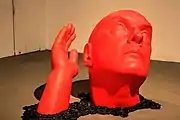 Uri Katzenstein, untitled sculpture at the Tel Aviv Museum of Art, August 2015
Uri Katzenstein, untitled sculpture at the Tel Aviv Museum of Art, August 2015 Uri Katzenstein exhibition, "The Institute of Ongoing Things", at the Joods Historisch Museum in Amsterdam, January 2019
Uri Katzenstein exhibition, "The Institute of Ongoing Things", at the Joods Historisch Museum in Amsterdam, January 2019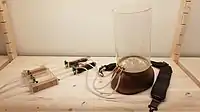 Uri Katzenstein exhibition, "The Institute of Ongoing Things", at the Joods Historisch Museum in Amsterdam, January 2019
Uri Katzenstein exhibition, "The Institute of Ongoing Things", at the Joods Historisch Museum in Amsterdam, January 2019 Uri Katzenstein exhibition, "The Institute of Ongoing Things", at the Joods Historisch Museum in Amsterdam, January 2019
Uri Katzenstein exhibition, "The Institute of Ongoing Things", at the Joods Historisch Museum in Amsterdam, January 2019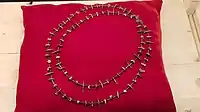 Uri Katzenstein exhibition, "The Institute of Ongoing Things", at the Joods Historisch Museum in Amsterdam, January 2019
Uri Katzenstein exhibition, "The Institute of Ongoing Things", at the Joods Historisch Museum in Amsterdam, January 2019
External links
- Official website
- "BackYard" by Uri Katzenstein on Vimeo
- "Home" a video installation by Uri Katzenstein on Vimeo
- The Institute of Ongoing Things, Uri Katzenstein interview on YouTube
- Uri Katzenstein on ArtLab
- Uri Katenstein at ZAZ10TS
- Uri Katzenstein / BACKYARD exhibit on PINZETA
- Uri Katzenstein at the Tel Aviv Museum of Art
- Uri Katzenstein on TimeOut
- Uri Katzenstein at the Haifa Museum of Art
- Prof. Uri Katzenstein lecturer page at the University of Haifa
- Uri Katzenstein on Mediations Biennale 2010 (Poland)
- VRAZILEK, JESSICA (August 12, 2015). "In his own BACKYARD". The Jerusalem Post. Retrieved October 5, 2016.
References
- ↑ האמן והמוזיקאי אורי קצנשטיין מת בגיל 67 (in Hebrew)
- ↑ "Uri Katzenstein: backyard The Dan Sandel and Sandel Family Foundation Sculpture Award, 2014". Tel Aviv Museum of Art. Retrieved June 27, 2015.
- 1 2 3 4 אורי קצנשטיין. מרכז המידע לאמנות ישראלי (in Hebrew). Retrieved June 27, 2015.
- ↑ Gal-Ezer, Miri. "From "silent generation" to cyber-psy-site, story and history: The 14th Tank Brigade battles on public collective memory and official recognition". cyberpsychology.eu. Retrieved June 27, 2015.
- ↑ Littman, Shany (May 22, 2015). האמן אורי קצנשטיין טיפל בפוסט טראומה שלו באמצעות כיסא בצורת צלב קרס. Haaretz (in Hebrew). Retrieved July 22, 2015.
- ↑ HACOHEN, HAGAY (January 27, 2019). "'NEW AGE' CRAWLS OUT OF THE WRECKAGE". The Jerusalem Post. Retrieved January 29, 2019.
- ↑ "Uri Katzenstein - ZAZ". ZAZ10TS. Retrieved February 6, 2019.
- ↑ "Uri Katzenstein". no-org.net no-org.net. Retrieved June 27, 2015.
- ↑ "Prof. Uri Katzenstein lecturer page". University of Haifa. Retrieved June 27, 2015.
- ↑ Armon Azoulay, Ellie (June 6, 2011). "Art in Haifa: thinking outside the box Artists who come from 'other places' reflect the University of Haifa's flexibility". Haaretz. Retrieved June 27, 2015.
- ↑ Asheri, Mia (August 25, 2018). "האמן והמוזיקאי אורי קצנשטיין מת בגיל 67" (in Hebrew). Haaretz. Retrieved March 9, 2022.
- ↑ Riva, Naama (February 3, 2019). "Finished Preparing the Exhibition and Died: Artist Uri Katzenstein Exhibiting in New York and Amsterdam" (in Hebrew). Haaretz. Retrieved February 5, 2019.
- ↑ "'Who comes after us?' answered in Holon". The Jerusalem Post. October 6, 2021. Retrieved October 8, 2021.
- ↑ Litman, Shany (November 17, 2014). אנג'לה קליין, אורי קצנשטיין וטל מצליח בין זוכי פרס מוזיאון תל אביב (in Hebrew). Haaretz. Retrieved June 27, 2015.
- ↑ Hoffman, Carl (March 6, 2015). "From 'Backyard' to front lawn". Jerusalem Post. Retrieved June 27, 2015.
- ↑ Yahav, Galia (May 7, 2015). "Veteran Israeli artist's exhibit is generous, sexy, and violent all at once". Haaretz. Retrieved June 27, 2015.